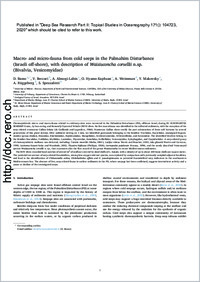Macro- and micro-fauna from cold seeps in the Palmahim Disturbance (Israeli off-shore), with description of Waisiuconcha corsellii n.sp. (Bivalvia, Vesicomyidae)
- Basso, D. University of Milano - Bicocca, Department of Earth and Environmental Sciences, CoNISMa, ULR of the University of Milano-Bicocca, Piazza della Scienza 4, 20126, Milano, Italy
- Beccari, Valentina University of Fribourg, Department of Geosciences, Chemin Du Musée 6, 1700, Fribourg, Switzerland
- Almogi-Labin, Ahuva Geological Survey of Israel, Jerusalem, 9371234, Israel
- Hyams-Kaphzan, O. Geological Survey of Israel, Jerusalem, 9371234, Israel
- Weissman, A. Department of Marine Biology, Leon H. Charney School of Marine Sciences (CSMS), University of Haifa, Haifa, 31905, Israel
- Makovsky, Y. Dr. Moses Strauss Department of Marine Geosciences and Hatter Department of Marine Technology, Leon H. Charney School of Marine Sciences (CSMS), University of Haifa, Haifa, 31905, Israel
- Rüggeberg, Andres University of Fribourg, Department of Geosciences, Chemin Du Musée 6, 1700, Fribourg, Switzerland
- Spezzaferri, Silvia University of Fribourg, Department of Geosciences, Chemin Du Musée 6, 1700, Fribourg, Switzerland
-
01.01.2020
Published in:
- Deep Sea Research Part II: Topical Studies in Oceanography. - 2020, vol. 171, p. 104723
English
Chemosymbiotic micro- and macro-fauna related to cold-seep sites were recovered in the Palmahim Disturbance (PD), offshore Israel, during EU EUROFLEETS2 SEMSEEP Cruise, by box-coring and Remotely Operated Vehicle (ROV) dives. No live macrofauna was identified in the collected sediments, with the exception of the seep-related crustacean Calliax lobata (de Gaillande and Lagardère, 1966). Numerous Calliax claws testify the past colonization of these soft bottoms by several generations of this ghost shrimp. After sediment sieving on 1 mm, we identified gastropods belonging to the families Trochidae, Eucyclidae, unassigned Seguenzioidea (genus Anekes), Rissoidae, Elachisinidae, Raphitomidae, Mangeliidae, Architectonicidae, Orbitestellidae, and Acteonidae. The identified bivalves belong to the families Nuculidae, Yoldiidae, Mytilidae, Lucinidae, Thyasiridae, Semelidae, Kelliellidae, Vesicomyidae, Xylophagidae, and Cuspidariidae. A seep-related group of chemosymbiotic molluscs was detected, including: Taranis moerchii (Malm, 1861), Lurifax vitreus Warén and Bouchet, 2001, Idas ghisottii Warén and Carrozza, 1990, Lucinoma kazani Salas and Woodside, 2002, Thyasira biplicata (Philippi, 1836), Isorropodon perplexum Sturany, 1896, and the newly described Vesicomyid species Waisiuconcha corsellii n. sp., that represents also the first record of the genus Waisiuconcha in recent Mediterranean sediments.The ROV dives recorded local patches of several m2 of seafloor covered by dead shells of L. kazani, with a density of up to about 200 loose shells per square meter. The potential occurrence of seep-related foraminifera, among low-oxygen tolerant species, was explored by comparison with previously sampled adjacent localities, and lead to the identification of Chilostomella oolina, Globobulimina affinis and G. pseudospinescens as potential foraminiferal seep indicators in the southeastern Mediterranean Sea. The absence of live, seep-related fauna in surface sediments in the PD, where seepage has been confirmed, suggests intermittent activity and a pause or decline of the investigated seeps.
- Faculty
- Faculté des sciences et de médecine
- Department
- Département de Géosciences
- Language
-
- English
- Classification
- Hydrology
- License
-
License undefined
- Identifiers
-
- RERO DOC 328441
- DOI 10.1016/j.dsr2.2019.104723
- Persistent URL
- https://folia.unifr.ch/unifr/documents/308538
Statistics
Document views: 165
File downloads:
- pdf: 601
